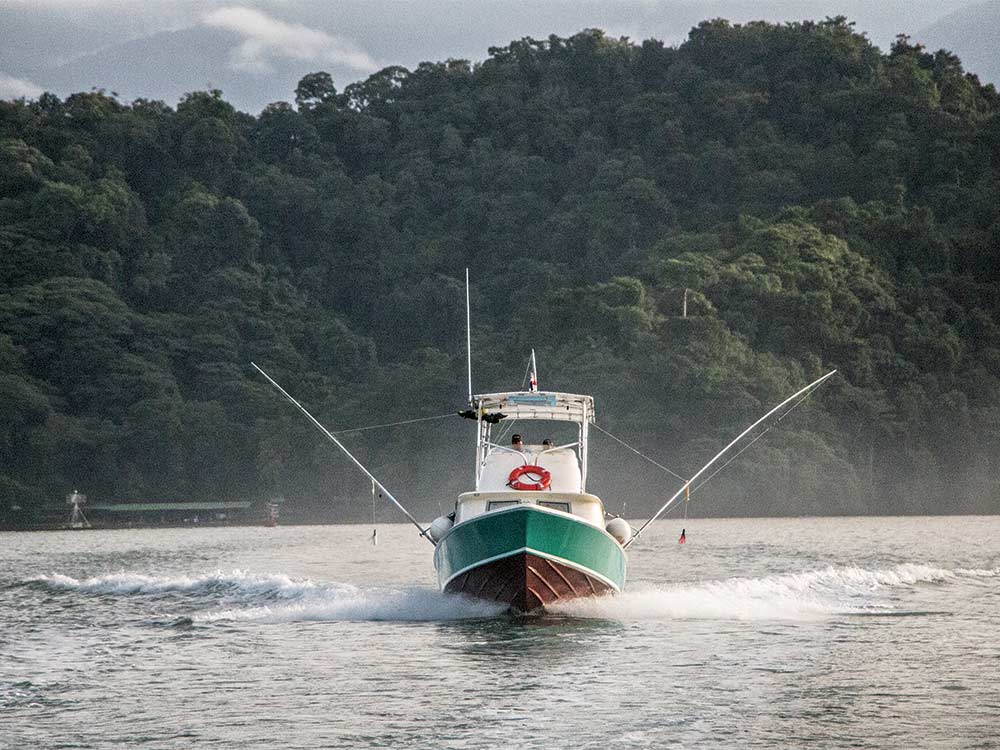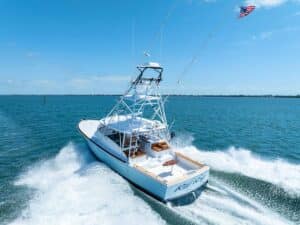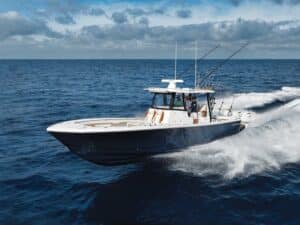
A far cry from the loud, smoky engines of the past, today’s diesel power is cleaner, quieter and more fuel efficient than ever before in the history of marine propulsion. Technological advancements have led to far greater power-to-weight ratios, while common-rail fuel delivery systems, turbochargers, exhausts and other elements have all become much more dynamic, allowing boats to achieve performance parameters that naval architects could once only dream of. A 70-footer cruising at 30 knots? No problem. Forty-plus knots at wide-open throttle? Another barrier shattered. Even 50 knots is not an unachievable goal for the next generation of sport-fishers. So if you have that need for speed, or just want better fuel economy in a quieter, more efficient engine, look no further.
MTU
The core brand of Rolls-Royce Power Systems AG, MTU is a leading provider of medium- and high-speed diesel engines for a wide variety of applications, as well as complete drives, distributed energy and fuel-injection systems.
The company, based in Friedrichshafen, Germany, also offers the highest-horsepower marine engine available today: the 16V 2000 M96L. At an incredible 2,600 hp, this is the choice for builders of today’s super-sport-fishermen, such as the 90-foot Jaruco from Jarrett Bay and Viking‘s 92-foot convertible and enclosed-bridge models, among many others.

MTU traces its 1909 origins to its original founders, Wilhelm Maybach and his son, Karl. The company built an experimental car in 1919, with the first production model introduced two years later at the Berlin Motor Show. They built engines for Germany’s huge zeppelin airships, then transitioned to yacht engines in the 1930s. The engines have always been a popular choice for sport-fishers thanks to their smooth operation, durability, long service life and reliable operation. While MTU produces engines in lower power ranges, its most popular options are the higher-horsepower V-10, V-12 and V-16 engines. The 8V 2000 M94 engines are rated at 1,250 hp, and there are also two 10-cylinder options, as well as two 12-cylinder engines, producing 1,800 and 1,920 hp, respectively. But the 2,600 hp 16V 2000 M96L remains at the summit of the high-horsepower recreational marine diesel-engine mountain — at least for now.
MAN
Another German company, MAN, has recently introduced a pair of new engines: the V-12 2000 and V-8 1300 series. MAN touts the 1300 as the strongest V-8 diesel yacht engine in the industry, and the 12-cylinder 2000 as the only V-12 producing 2,000 hp. Both have excellent power-to-mass ratios and retain the compact installation dimensions of the engines they replace in the MAN line.“With the V-12 2000 and the V-8 1300, we have set a new benchmark for performance and compactness,” says Claus Benzler, head of marine MAN engines.

The performance-oriented design is supported by an improved injection system and new turbocharger, as well as newly developed cylinder heads and an adjusted cooling system. A new crankcase, which has been reinforced in significant areas, ensures high performance throughout the entire engine’s long service life. The highly efficient combustion means low fuel consumption coupled with quieter sound levels.
“Our engines have always offered performance at the highest level, and will continue as such in the future,” Benzler says. Both engines meet the current EPA Tier 3 and IMO Tier II emission regulations. With the inclusion of these two new engines, MAN now offers marine diesels ranging from 730 to 2,000 hp.
Read Next: New Boats of 2019
Cummins
In 2014, Casa Vieja Lodge in Guatemala selected Cummins engines for two important re-power projects: Release, a 37-foot Merritt, and Makaira, a 37-foot Rybovich. Fitting both boats with the 380 hp Cummins QSB6.7s rendered the lodge’s inboard fleet with a single unified engine-brand affiliation.
“With the way Cummins engines have performed in the rest of our boats and the support we get from them, there was no question that we wanted to re-power these two boats with Cummins engines,” says Capt. David Salazar, owner of Casa Vieja Lodge. “The QSB6.7 was the perfect fit, and will give us the performance we can depend on during a busy charter season.”

The Cummins QSB6.7 has the highest power density for the recreational marine market, producing up to 550 hp and meeting EPA Tier 3 marine emissions regulations. The QSB6.7 offers more torque, better performance and improved acceleration; reduced noise; and reduced vibration over the highly regarded Cummins QSB5.9, without sacrificing fuel economy.
Cummins also offers factory-reconditioned engines under its ReCon program. Every ReCon engine is completely disassembled and thoroughly cleaned, inspected and restored to its original factory specifications. Critical components, such as rings, bearings, seals and gaskets, are replaced with new Cummins parts. After final assembly, computerized engine tests ensure like-new performance. These reconditioned engines are covered by a two-year/2,000-hour warranty, which includes coverage for parts, labor and technician travel. The corporate offices for Cummins are located in Columbus, Indiana.
Caterpillar
A consistent choice for boatbuilders, especially in the Carolinas, Caterpillar marine engines set the standard for quality, performance and reliability. An extensive power range and decades of experience result in a single source for total power solutions on board, including electronic marine engines, generators, motors and controls. Continual advancements in electronic engine technology mean Cat marine engines satisfy worldwide emissions regulations and continue to deliver a reliable and powerful product whenever and wherever required. Behind the scenes is an unmatched customer support network, which is priceless, especially when traveling to those far-flung exotic fishing destinations.

Caterpillar is the engine of choice for Hull 140 from Paul Mann Custom Boats in North Carolina. This 63-foot custom sport-fisher will feature twin Cat C32 ACERT engines, delivering 1,600 hp each.“We are very excited and grateful to build this 63-footer,” Mann says. “She will be well-appointed, fully equipped and tournament ready, but also designed for traveling in comfort and style to any desired destination for family fun.”
The 12-cylinder C32 ACERT engines are compliant for U.S. EPA Tier 3 recreational, EU Stage IIIA and IMO II emissions. The 1,600 and 1,800 hp ratings also meet U.S. EPA Tier 3 commercial standards. The engine configuration includes an air cleaner and crankcase ventilation system, as well as jacket water aftercooling system. Additional features include a plug-in power takeoff, a mobile electronics certified professional control panel and hybrid fuel lines. The MECP I panel has a monochrome display for engine parameters, external outputs for customer-installed visible and audible alarms, start/stop buttons, and an off/local/remote switch.
Volvo Penta
In late 2018, Panama’s Tropic Star Lodge announced that it is upgrading its fleet of 13 popular 1970s-vintage Bertram 31s with modern, fuel-efficient and environmentally friendly engines from Volvo Penta. Located in the über-remote Darien Rainforest on Piñas Bay, Tropic Star is a world-renowned location that’s well-known for its outstanding black marlin fishery.
The Tropic Star team began planning for modernizing the boats’ aging propulsion plants several years ago. After a comprehensive evaluation, it decided on a package of twin Volvo Penta 4-liter inboard diesel engines combined with reliable ZF transmissions.
“We are very pleased with the result of our decision,” says Ursula Marais, operations director and CEO of Tropic Star. “Volvo Penta demonstrated a great deal of flexibility and a commendable commitment to customer service in meeting our requests.” The first three engine installations have already been completed, and the remaining retrofits will be on a phase-in schedule to minimize disruption to the lodge’s fishing operations.

“This successful fleet re-power project for Tropic Star — in one of the least accessible locations in the Americas — is a great testimony to the reliability and efficiency of our D4 engine platform, along with the creativity of our application engineering team and our dedicated service dealer in Panama,” says Dave Brown, director of commercial marine sales of Volvo Penta of the Americas.
Volvo Penta applications engineer Guilherme Tait explains that Tropic Star had very specific criteria for the replacement engines, based on their unique situation. The most important consideration was reliability, since the remote Pacific location is accessible only by boat or charter plane and requires the staff to be self-sufficient. All maintenance, service and repairs are performed on-site in the resort’s own boatyard. The location also dictates the usage patterns for the boats. The distance to the fishing grounds is short, and the boats spend the great majority of their time slow-trolling with live bait.
Since the engine compartment on the Bertram 31 is constricted, space was also an issue. As a final consideration, the environmentally conscious lodge owners wanted to meet U.S. EPA Tier 3 emission levels. The Volvo Penta 4-liter engine was a perfect choice, and easily fit into the restricted engine space, Tait says. Volvo Penta also devised a custom trolling mode that permits operation at low revolutions per minute, and added an extra alternator pulley on the engine to drive an air-conditioning compressor.
The installations were performed at Tropic Star with technical support and advice from the Volvo Penta application engineering team and assistance from CDM, the Volvo Penta dealer in Panama. The first re-power now has more than 1,600 hours on the new engines. Tait says the motors are also delivering about 45 percent in fuel savings.
Read Next: Design Secrets of Naval Architects
ZF Marine
With a wide range of lightweight and robust transmissions suitable for all types of engine and propulsion systems, ZF is a very popular choice among today’s boatbuilders. Among the notable benefits is the ZF AutoTroll system, which provides an infinitely variable propeller-speed control when there is a need to slow down the shaft speed. AutoTroll allows operators to increase or reduce transmission slip to match the exact amount of thrust required during low-speed operation for extended periods without risking damage to the transmission. Uses include slow-speed trolling or live-baiting, plus no-wake operation, dockside maneuvering and more.
Another popular option is the Joystick Maneuvering System. Interfaced with ZF Marine’s SmartCommand control systems controlling the engines in a twin-engine vessel with a traditional shaft-and-rudder system, JMS provides the same ease of control as azimuth pod-drive systems.
All ZF control systems are designed to smoothly interface with most engine options, whether in recreational, professional or heavy commercial applications. They comply with the highest classification standards, and make installation easy for boatbuilders and operation comfortable for boat owners.
The Future
Engine manufacturers are currently supplying EPA-mandated Tier 3-compliant engines, and there is little doubt that even more stringent Tier 4 standards are on the horizon for the recreational marine sector. How this will affect the next generation of sport-fishers remains to be determined. As boats continue to grow in size and performance, builders and owners continue to clamor for higher-horsepower engines to meet those expectations. With the current ceiling capped at 2,600 hp, it will be interesting to see if engine manufacturers respond with a 3,000-plus hp recreational marine diesel engine in the near future.







